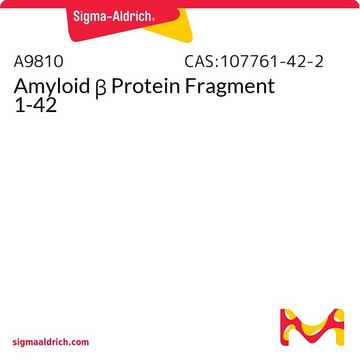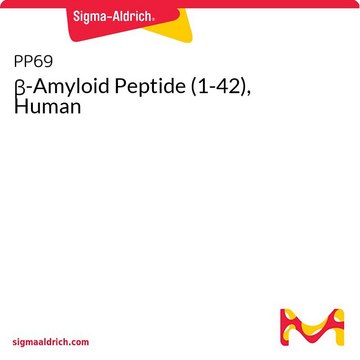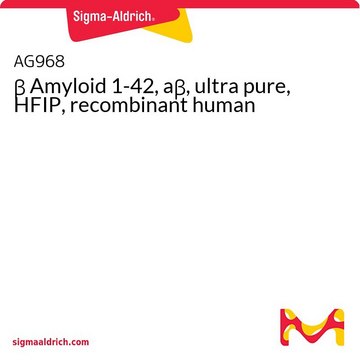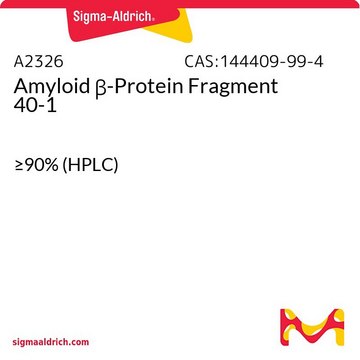SCP0037
Amyloid β 1-40 rat
≥95% (HPLC)
Autenticatiper visualizzare i prezzi riservati alla tua organizzazione & contrattuali
About This Item
Formula empirica (notazione di Hill):
C190H291N51O57S1
Peso molecolare:
4233.72
Codice UNSPSC:
12352200
NACRES:
NA.32
Prodotti consigliati
Saggio
≥95% (HPLC)
Stato
lyophilized
Composizione
Peptide Content, ≥75%
Condizioni di stoccaggio
protect from light
Temperatura di conservazione
−20°C
Amino Acid Sequence
Asp-Ala-Glu-Phe-Gly-His-Asp-Ser-Gly-Phe-Glu-Val-Arg-His-Gln-Lys-Leu-Val-Phe-Phe-Ala-Glu-Asp-Val-Gly-Ser-Asn-Lys-Gly-Ala-Ile-Ile-Gly-Leu-Met-Val-Gly-Gly-Val-Val
Applicazioni
Amyloid β (Aβ) refers to peptides derived from Amyloid precursor protein that vary in length from 36-43 amino acids. Aβ(s) peptides, their peptide fragments and mutated fragments are used to study a wide range of metabolic and regulatory functions including activation of kinases, regulation of cholesterol transport, function as a transcription factor, and regulators of inflammation. Aβ(s) peptides and their peptide fragments are also used to study oxidative stress, metal binding and mechanisms of protein cross-linking in the context of diseases such as Alzheimer′s disease and neurodegeneration.
Codice della classe di stoccaggio
11 - Combustible Solids
Classe di pericolosità dell'acqua (WGK)
WGK 1
Punto d’infiammabilità (°F)
Not applicable
Punto d’infiammabilità (°C)
Not applicable
Scegli una delle versioni più recenti:
Certificati d'analisi (COA)
Lot/Batch Number
Non trovi la versione di tuo interesse?
Se hai bisogno di una versione specifica, puoi cercare il certificato tramite il numero di lotto.
Possiedi già questo prodotto?
I documenti relativi ai prodotti acquistati recentemente sono disponibili nell’Archivio dei documenti.
I clienti hanno visto anche
Xuehong Yu et al.
Neurobiology of learning and memory, 123, 168-178 (2015-06-14)
Single-session anodal transcranial direct current stimulation (tDCS) can improve the learning-memory function of patients with Alzheimer's disease (AD). After-effects of tDCS can be more significant if the stimulation is repeated regularly in a period. Here the behavioral and the histologic
Maryam Bagheri et al.
Neurobiology of learning and memory, 95(3), 270-276 (2010-12-15)
Alzheimer's disease (AD) is a debilitating neurodegenerative disorder characterized by increased β-amyloid (Aβ) deposition and neuronal dysfunction leading to impaired learning and recall. Ageing, heredity, and induced oxidative stress are among proposed risk factors. The increased frequency of the disease
Aynun N Begum et al.
Journal of Alzheimer's disease : JAD, 15(4), 625-640 (2008-12-20)
The rat amyloid-beta (Abeta) intracerebroventricular infusion can model aspects of Alzheimer's disease (AD) and has predicted efficacy of therapies such as ibuprofen and curcumin in transgenic mouse models. High density lipoprotein (HDL), a normal plasma carrier of Abeta, is used
Lian Hong et al.
The journal of physical chemistry. B, 114(34), 11261-11271 (2010-08-10)
There is no consensus on the coordinating ligands for Cu(2+) by Abeta. However, the differences in peptide sequence between human and rat have been hypothesized to alter metal ion binding in a manner that alters Cu(2+)-induced aggregation of Abeta. Herein
Tania Araujo Viel et al.
Neurobiology of aging, 29(12), 1805-1814 (2007-06-16)
Although numerous inflammation pathways have been implicated in Alzheimer's disease, the involvement of the kallikrein-kinin system is still under investigation. We anatomically localized and quantified the density of kinin B(1) and B(2) receptors binding sites in the rat brain after
Il team dei nostri ricercatori vanta grande esperienza in tutte le aree della ricerca quali Life Science, scienza dei materiali, sintesi chimica, cromatografia, discipline analitiche, ecc..
Contatta l'Assistenza Tecnica.








